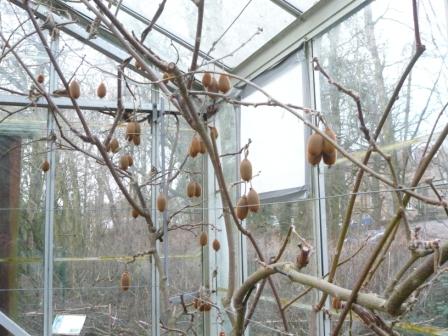Kiwi Fruit the Chinese Gooseberry
Kiwi fruit known as the Chinese goodeberry grow on the woody vine Actinidia deliciosa and its hybrids. The vines should be grown on sturdy support structures as it crops more than the rather weak vines can support.This plant has a cold greenhouse for protection but they can be grown outdoors in a sheltered spot.
Growing Tips
- Plants are prone to frost damage.
- Fruit is borne on one-year-old and older canes, but production declines as each cane ages. Canes should be pruned off and replaced after their third year.
- Kiwifruit vines require vigorous pruning similar to that of grapevines.
- Only female plants bear fruit, and then only when pollinated by a male plant.
- The cultivar ‘Issai’, a hybrid Actinidia arguta x polygama from Japan can self-pollinate; unfortunately it lacks vigour, is less hardy than most Kiwi fruit and is not a large producer. ‘Jenny’ is partly self-fertile and so is worth trying where space is limited.
- ‘Hayward’ is the most widely grown, least vigorous and latest-flowering female cultivar with oval fruits of a good flavour.
- Of the male varieties ‘Tomuri’ is the latest to flower so is the best to partner ‘Hayward’.
Kiwi fruit have high levels of vitimin C, dietry fibre and almost as much potassium as Bananas.
Actinidia originate from China, Japan and Indonesia but are grown and cropped commercially in NewZealand hence the name given to the fruit in the 1950’s.
The leaves particularly of male plants can have very ornamental variegation of pink white and green.

